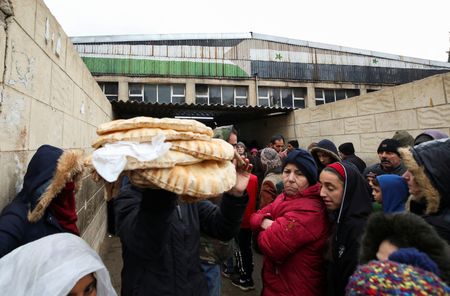DAMASCUS/BEIRUT (Reuters) – After her son was killed fighting for the Syrian government in 2013, the state began paying Amouna al-Berri a monthly salary which easily covered all her household expenses.
Today, the “martyrs salary” – given to families of people who have died for Damascus in the 11-year long war – barely pays for her diabetes medicine.
Like many Syrians, Berri says getting by is harder today than at any point during the conflict, even though it has been several years since the last major battles and President Bashar al-Assad is firmly in control of most of the country.
“It was easier in the war. Things weren’t as expensive as now,” said Berri, 50, sitting next to a picture of Assad as she spoke at her home on the outskirts of Damascus, where she has lived since fleeing fighting in Aleppo nearly a decade ago.
She cannot afford to warm her home, a makeshift shelter in an unfinished building with blankets for walls.
With one son killed, a second wounded in fighting, and a third missing for a decade, Berri has paid a high price in the war that spiralled out of protests against Assad’s rule in 2011.
Across Syria, the human cost of the war has been huge, including more than 350,000 people killed and over half the population uprooted, many of them from former rebel enclaves that were bombed into submission by Damascus and its allies.
But while the frontlines have been largely frozen for years, an economic crisis is exacting an increasingly heavy toll across the fractured nation. The United Nations says the number of people in need of humanitarian support is greater than at any point since the war began.
At the time of her son’s death, Berri’s monthly allowance – 30,000 Syrian pounds – was worth around $150. Today, it amounts to $6, reflecting the economy’s downward spiral.
“Sometimes I cry, sometimes I get upset, sometimes I think about leaving (the country), but if I do, how will we live?”
Already hit by extensive damage to infrastructure and industries during the war, the once productive Syrian economy has nose-dived further since 2019, when contagion from neighbouring Lebanon’s financial crisis led the Syrian pound to collapse.
The pound holds less than 2% of the value it had in 2011.
The number of people in need reached 14.6 million in 2021, a 1.2 million increase from 2020, the United Nations says. Extreme poverty is estimated at almost two thirds of the roughly 18 million people living in Syria today.
Damascus blames the mounting misery mainly on sanctions, which were tightened by Washington in 2020, deepening Syria’s isolation. Western states say they aim to put pressure on Assad to end repression and negotiate a political settlement.
APPEALING FOR HELP
Assad’s enemies, including Turkey-backed insurgents, control the northwest, home to some 2.8 million people forced from their homes who have also been enduring an exceptionally tough winter https://www.reuters.com/world/middle-east/snow-storms-cold-fire-threaten-displaced-syrians-northern-camps-2022-01-25. Much of the east and northeast – including oil and farm land – is held by Kurdish-led forces backed by Washington.
The pandemic and a drought have added to the pressures.
With the war already having driven 6.6 million people out of Syria, some residents of the capital say hardship is encouraging more to leave: one Damascus resident said she knew of 50 people who left late last year.
Others use social media to seek help.
In one Facebook post, a woman from Damascus who lost her husband in the war appealed for two blankets to help keep her children warm. In another, a woman asks if anyone has a heater to spare.
“I would like the situation to get better, so I don’t have to leave,” said Kawthar Al Saleh, 28, a journalist.
“My salary is enough to cover transportation costs for one week only or 10 days. Other things like food, cannot be covered by my salary,” said Saleh, who lives with her parents.
MORE CHILD LABOUR, DEBT
“What you have is a cascade of crises,” Imran Riza, U.N. Resident Coordinator and Humanitarian Coordinator in Syria, told Reuters. “We are seeing levels of poverty that we haven’t seen before, levels of need that we haven’t seen before,” he said.
“You see a lot of people moving towards very negative coping mechanisms – more child labour, more child marriage, very high levels of debt right now. People selling key household assets.”
Anna Cervi, country director of the Norwegian Refugee Council, said people across the country were being forced to make dramatic choices, such as whether a sick parent should pay for medical treatment, “or save that money to put a meal on the table for their kids.”
The government has sought to address the situation by increasing public sector wages and pensions, most recently in December. However, worsening conditions and subsidy cuts have led to protests https://www.reuters.com/markets/rates-bonds/syrias-main-druze-city-sees-more-unrest-calls-friday-protests-2022-02-10 in the southwestern city of Sweida this month.
A Syrian family needs 450,000 to 500,000 a pounds a month to cover essentials including food, power, medicine and rent, according to a Norwegian Refugee Council survey.
“Every house is in need of help, even state employees and middle-income people,” said Issam Habbal, the head of Sa’ed, an NGO.
Fouad Chahine, a state employee, rarely buys clothes for his three children. His salary of 120,000 pounds is spent within three days. He tops up his income by selling nuts.
“In 2013, life was more comfortable than now. Now you sleep, wake up and see that prices have gone up,” he said.
(Additional reporting by Tom Perry and Maya Saad in Beirut; Writing by Tom Perry; Editing by Frank Jack Daniel)





